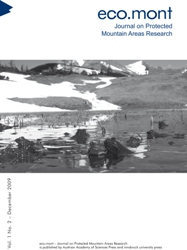Marc Sztatecsny,
Walter Hödl
S. 19 - 24
doi:
10.1553/ecomont2s19
Verlag der Österreichischen Akademie der Wissenschaften
doi:
10.1553/ecomont2s19
Abstract:
In June 2004 and June 2005, we checked 40 and 134 ponds respectively for alive and dead alpine newts, common toads, common frogs, and their clutches on the "Kirchfeld" plateau in the Northern Limestone Alps of Austria. We found several hundred dead common frogs and alpine newts in the two consecutive years and also observed an unusually high number of heterospecific matings between common toads and common frogs in 2004. In order to test whether the observed mortalities were caused by disease, we screened 98 individuals of the three species for chytridiomycosis, a highly infective fungal disease, in 2008. All samples proved to be negative. We therefore assume that the high losses for the common frog population (26 % in 2004 and 9 % in 2005) during the spring migration, as well as the breakdown of the temporal premating isolation between the common frog and common toad, were caused by temperature anomalies alone, i.e. sudden low temperatures after a warm spring period. The high number of dead alpine newts found in 2005 was negatively correlated to the oxygen saturation of the ponds, frequently covered by ice during the early breeding season. We discuss the possible effects of climate change on phenological timing, breeding isolation and chytridiomycosis in alpine amphibian populations.
2009/11/26 12:32:03
Object Identifier:
0xc1aa5576 0x0022aa09
Rights:https://creativecommons.org/licenses/by-nc-nd/4.0/
The journal “eco.mont” – Journal of protected mountain areas research and management – was published for the first time in June 2009.
The journal was founded as a joint initiative of the Alpine Network of Protected Areas (ALPARC), the International Scientific Committee on Research in the Alps (ISCAR), the Austrian Academy of Sciences (ÖAW) and the University of Innsbruck.
The journal aims to highlight research on and management issues in protected areas in the Alps without excluding other protected mountain areas in Europe or overseas. Its target audiences are scientists from all related disciplines, managers of protected areas and interested individuals including practitioners, visitors, teachers, etc.
The journal presents peer-reviewed articles in English by authors who research protected mountain areas and management issues within these areas. It's published twice a year as a collaboration of the Austrian Academy of Sciences Press – responsible for the e-version – and Innsbruck University Press – responsible for the print version.
Die Zeitschrift „eco.mont“ – Zeitschrift zur Forschung in Gebirgsschutzgebieten – erschien im Juni 2009 zum ersten Mal. Die Zeitschrift wurde auf Initiative des Netzwerks Alpiner Schutzgebiete (ALPARC), der Schweizer Akademie der Naturwissenschaften (ISCAR), der Österreichischen Akademie für Wissenschaft (ÖAW) und der Universität Innsbruck gegründet. Sie hat das Ziel, Themen zu behandeln, die gleichzeitig Forschung und Verwaltung in und über die Schutzgebiete der Alpen betreffen, ohne dabei andere Gebirgsschutzgebiete Europas oder anderswo auszuschließen. Diese neue Zeitschrift richtet sich an ein Publikum von Wissenschaftlern der verschiedensten Fachbereiche, an die Verwalter von Schutzgebieten und an alle sonstigen Interessierten, Praktiker, Besucher, Lehrpersonal etc. einbegriffen. Die Zeitschrift veröffentlicht begutachtete Beiträge auf Englisch von Autoren, die Fragen der Gebirgsschutzgebieten und deren Verwaltung forschen. Sie erscheint zweimal pro Jahr, auf der Basis der gemeinsamen Anstrengungen des Verlags der Österreichischen Akademie der Wissenschaften, der für die digitale Fassung verantwortlich ist, und der Presse der Universität Innsbruck, verantwortlich für die gedruckte Fassung.



 Home
Home
 Print
Print
 References
References
 Share
Share

